A special relationship with Otago Museum offers exciting opportunities for research and study in the Classics programme.
Research and study opportunities
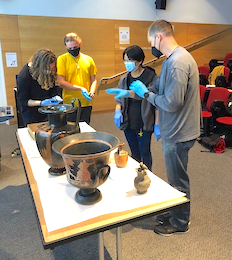
Dr Dan Osland leading discussion on the human form in Greek art with Anatomy students studying Classics.
Otago Museum possesses the finest collection of ancient Greek vases and Roman coins in New Zealand. The wider Classics collection includes pottery, coins, metals, and glass from the cultures of the ancient Mediterranean. It also includes replicas of iconic objects and statues.
Staff and students arrange access to collections in storage through their Classics papers, research projects, Division of Humanities (HUMS) internship opportunities, and Classics Society membership (CLASSOC). Classics staff and students also contribute to the enhancement of those collections through their research and study.
More about studying and research in Classics
Humanities internships
Working with the Museum the Classics Programme can arrange for Humanities internships (HUMS 301 and HUMS 401) focusing on aspects of the Museum's Classical collection. Projects involve a combination of research, documentation (photography, data entry, etc.), and writing, sometimes with a public focus.
These internships have greatly contributed to the Museum's efforts at digitising the collections and updating the collection database. Through this collaboration with the Otago Museum, Classics interns have been able to gain hands-on experience working with Greek and Roman coins, ancient glass, Roman pottery, and a range of terracotta and metal figurines from the ancient Mediterranean world.
Greek and Roman coin collections
Many of our students are working with the Otago Museum Roman coin collection as part of their coursework at the 300- and 400-level. The coins cover the period from the third century BC to the fifth century AD. In Australasia this collection is second only to Macquarie University, Sydney.
Otago's coin collection: Dr Gwynaeth McIntyre interviewed by Jesse Mulligan 2018 (RNZ website)
The expertise of Classics staff is also enhancing the coin collections through cataloguing, digital capture, dissemination of research, and the development of teaching approaches.
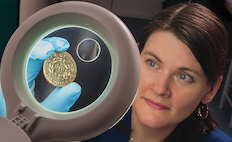 Associate Professor Gwynaeth McIntyre, Head of Programme, and Dr Dan Osland have been working on a number of projects associated with digitising and cataloguing the Greek and Roman coin collections. Digitisation of the Roman coin collection was generously funded through a University of Otago Research Grant. Division of Humanities interns began digitising the Greek coin collection in 2021, they had been previously catalogued by a former Classics faculty member, and Otago Museum Honorary Curator, Dr Chris Ehrhardt.
Associate Professor Gwynaeth McIntyre, Head of Programme, and Dr Dan Osland have been working on a number of projects associated with digitising and cataloguing the Greek and Roman coin collections. Digitisation of the Roman coin collection was generously funded through a University of Otago Research Grant. Division of Humanities interns began digitising the Greek coin collection in 2021, they had been previously catalogued by a former Classics faculty member, and Otago Museum Honorary Curator, Dr Chris Ehrhardt.
Otago Magazine, see Issue 47, p37: Roman currency
Museum's Roman coin collection being digitised, 26 February 2019 (ODT website)
Students create coin exhibitions
Using a University Teaching Development grant (CALT) Associate Professor Gwynaeth McIntyre has enabled students to create coin online exhibitions and posters as part of their course work. Gwynaeth's paper on this group work was published in the Journal of Classics Teaching.
Coins in the Classroom – Teaching Group Work with Roman Coins McIntyre, G., Dunn, C., Richardson, W.P.
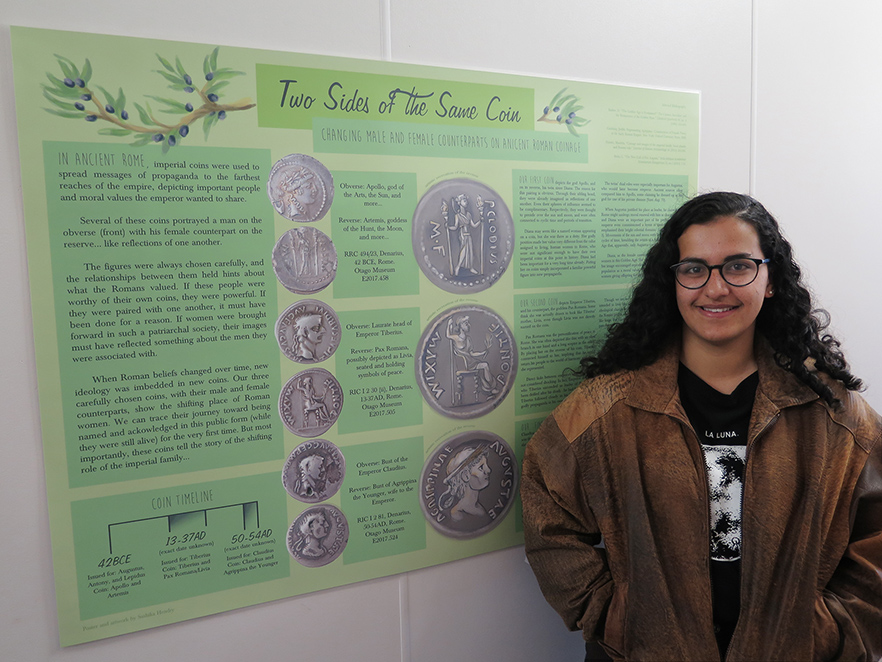
CLAS 444 Advanced Studies student Sashika Hendry with her Roman coin research poster on display in the Arts Building on Dunedin campus.
CLAS 344 From Augustus to Nero: Scandal and Intrigue in Imperial Rome students created:
A CLAS 480 Research Paper student created an online exhibition of two of Sextus Pompeius' coins.
How to read a coin
Student exhibitions: Anatomy of a coin
Roman pottery and glass
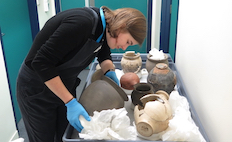
Joanne Jones examining a Romano-British vessel from the Otago Museum's collection.
The Otago Museum's Classical World collection has also provided research opportunities for postgraduate students with the Roman pottery, and the Museum's extensive Roman glass objects.
Honours student Joanne Jones conducted a review of the Romano-British pottery collection. "As a budding archaeologist, the thought of being able to handle such a large collection of 2000-year-old artefacts was very exciting."
As part of her research she examined each piece of origin information from every artefact in the collection. "From the form, material, and decoration styles of each artefact, I was able to both eliminate any artefact that had been mislabelled as being Romano-British in origin and begin to quantify the collection."
Visit a post about Joanne's work:
A Brief Foray into Romano-British Archaeology (Christchuch Uncovered blog)
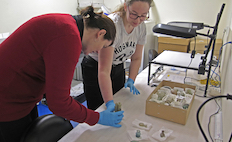
From left: Dr Gwynaeth McIntyre and Andy MacManus with artefacts from the Roman glass collection.
Masters' candidate Andy MacManus studied Roman glass. Andy's research aims to understand the modern journey of these items prior to their acquisition by the Museum and the original contexts and uses.
Roman Glass in the Otago Museum: Andy MacManus
Classics postgraduate study
Postgraduate study in Classics
Current postgraduate research opportunities
Classics postgraduate students and their research
Otago Museum's Classical Teaching Collection
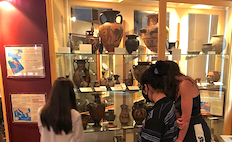
Greek vases on display in the People of the World gallery at Otago Museum.
The Otago Museum has Classical Teaching Collection pages online specially curated for Classics papers.
Members of the public can also view many of these treasures in the People of the World Gallery, Level two, at the Otago Museum.
More about the People of the World Exhibit at Otago Museum
CLAS 105: Greek Mythology
This online selections showcases some of the mythological narratives discussed in the University of Otago Department of Classics' paper Greek Mythology. The Otago Museum possesses the finest collection of ancient Greek vases in New Zealand, and the online selection represents a small fraction of those that are currently on display.
CLAS 108: Classical Art and Archaeology: Of Heroes, Gods and Men
This small set of pottery was chosen as a schematic representation of some of the vessels that would have been used in a typical Athenian symposium. The symposium was an aristocratic drinking party traditionally attended by (male) citizens, and served as a setting in which to reinforce group solidarity and to enhance social standing.
Otago Museum: Classical Art and Archaeology
CLAS 108: Classical Art and Archaeology: Of Heroes, Gods and Men
CLAS 354: Tales of Troy: From Homer to Hollywood
Many scholars today do believe that there are grains of historicity scattered throughout the Iliad and the Odyssey, and that later written and artistic depictions of the Trojan War can be helpful in better understanding the context of this early encounter between East and West. The diverse materials in this online collection contribute to that exploration.
